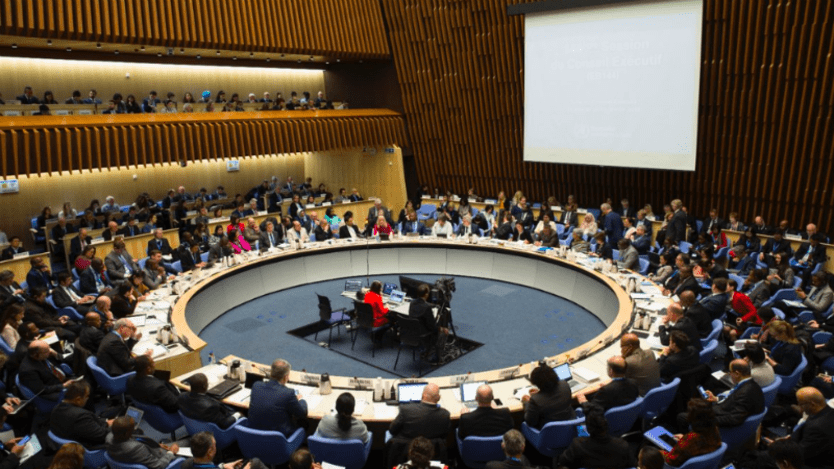
The global health community is gearing up for 2019 in full force at the 144th World Health Organization Executive Board meeting. Key gender equality discussions are underway, with WHO transformation and universal health coverage center stage.
WHO Director-General Dr. Tedros Adhanom opened the meeting with an optimistic call for change — and despite WHO’s vocal and written commitment to advancing gender equality, concerns were raised that gender-related determinants of health and broader gender equality may once again be left behind.
To this, the director-general replied: “gender should be mainstreamed. It can’t be done by a small unit — it needs to be done by each and every person. It’s everybody’s business and we have to mainstream it in our organization.”
The WHO Secretariat and member states responded to the call for action on gender equality in UHC. Here are five things we hope to see beyond the 144th executive board meeting:
1. Address gender equality and women’s empowerment at the 2019 UN High-level Meeting on UHC
Tedros addresses alleged misconduct at WHO
"As WHO's leadership ... we want to know the truth more than anybody," Tedros told member states at the 144th executive board meeting in Geneva, after anonymous emails were sent to WHO directors.
We must have strong, sustainable, and people-centered health systems that can systematically address the gender-related barriers that create health inequities and determine delivery and access to health. UHC is currently the most hotly debated and visionary goal in global health.
UHC cannot be achieved anywhere without addressing gender equality and, particularly, the role of women in the global health workforce. The U.N. High-level Meeting on UHC is meant to leave no one behind, while preliminary planning documents had no mention of gender determinants or sexual and reproductive health and rights, we applaud WHO in the shift and the clear inclusion of gender aspects.
2. Greater commitment for gender parity from WHO’s Executive Board
This starts in the WHO’s Executive Board’s own representation. Of 34 member state representatives sitting around the board table, only 8 — or 24 percent — are women. While we are motivated that women hold the most active executive board roles, such as chairman and vice-chairman, equal numbers of women and men will demonstrate that global health leadership is drawing from the total pool of talent.
Most of the representatives — 21 of 34 — are experts nominated by their governments, not ministers. This means that the responsibility of appointing diverse representatives lies with the represented nations, as much as it does with WHO. There’s no reason there could not be gender parity at a meeting of such importance to the future of global health and health for all. We hope to see this change made by member states at the World Health Assembly in May.
3. A gender transformative investment in the current and future worldwide health workforce has an SDG Dividend
Countries have to fill a predicted 18 million new health jobs by 2030 in order to reach UHC by 2030. Building up the worldwide health workforce will be a top country priority. To successfully reach these goals, countries will have to be gender transformative and invest in the workforce. Women make up 70 percent of the health workforce, and if enabled, they will deliver UHC.
4. An inclusivity advisory and oversight group for WHO, a key recommendation of the WHO Civil Society Task Force
Discord looms over WHO board meeting
Civil society members are questioning their space for participation at the meetings, and some powerful member states are likely to challenge WHO's latest reports on cancer drug pricing and access to medicines.
WHO, the executive board, director-general, member states, and civil society organizations must all commit to change the culture at WHO to make sure that there is zero tolerance of all forms of discrimination — especially harassment — and that gender and broader inclusion is achieved. Organizational culture at WHO must create an enabling, safe, and dignified working environment for all genders. An inclusivity advisory and oversight group would help to develop and evaluate policies and to provide formal support on gender, youth, equity, and rights mainstreaming.
5. WHO remains active in addressing root inequities that impact health for all, such as SDG 5, by establishing an accelerator in the SDG3 Global Action Plan
While WHO may not see itself as a guardian of all the SDGs, WHO, and all multilateral health agencies are still committed to much more than SDG 3: to ensure healthy lives and promote well-being for all at all ages.
SDG 3 cannot be achieved in a silo because all of the SDGs are interdependent. SDGs 3 and 5 go hand in hand, with gender equality being cross-cutting. We cannot address gaps in global health without addressing the gender norms that, for example, drive the poverty that affects women more than men and makes health care unaffordable for many, even where it does exist. Broader goals such as SDG 5 still impact the health and well-being of lives everywhere.
We hope member states continue to respond to our call to action on gender equality. Addressing gender equality is central to every aspect of global health, and every item listed on the WHO EB meeting agenda rests on getting it right.










